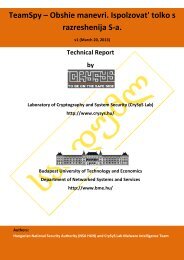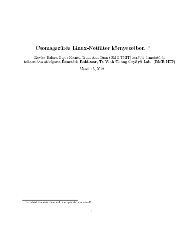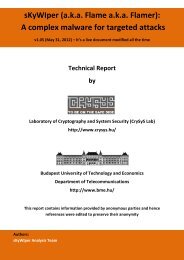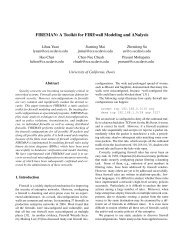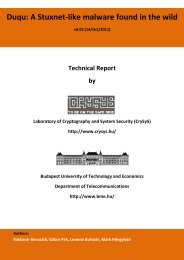Understanding Security APIs - CrySyS Lab
Understanding Security APIs - CrySyS Lab
Understanding Security APIs - CrySyS Lab
You also want an ePaper? Increase the reach of your titles
YUMPU automatically turns print PDFs into web optimized ePapers that Google loves.
The most widely deployed DRM mechanisms are currently in consumer electronics.<br />
For example, Sony Memory Sticks – Flash based digital storage media – have<br />
‘protection bits’, that mark certain files with ‘do not copy’, or ‘only retrievable by<br />
authorised Sony devices’ tags. DVDs also have DRM mechanisms for ‘region control’,<br />
a finer market segmentation method which allows geographically staggered<br />
release dates, and makes trafficking illegal bitwise copies slightly harder. None of<br />
this technology is highly tamper-resistant, though modern miniaturised circuitry<br />
does discourage straightforward physical attack.<br />
There are more DRM mechanisms that begin to look like <strong>Security</strong> <strong>APIs</strong>. They<br />
are usually software based, and just like their hardware counterparts they rely upon<br />
obscurity and obfuscation. Third party copy-protecting encapsulation has been used<br />
for distribution of electronic books, and similar techniques have been tried for audio<br />
and video media. A common paradigm is to have support software entrench itself<br />
in the operating system, storing protected media in encrypted form, and hiding<br />
the keys. This O/S add-on then presents a <strong>Security</strong> API to some graphical user<br />
interface which the end-user will use to manage his or her media collection. These<br />
third-party packages are often general-purpose, so have properties much like generalpurpose<br />
crypto <strong>APIs</strong>. They will support binding of media to a particular PC or<br />
system configuration, expiring licences, and process feature codes which change the<br />
access control policies, or unlock further content. Additional features and repeat<br />
subscriptions can thus be sold to users without the need for further downloads of<br />
large binaries.<br />
Examples of these packages include:<br />
• Folio Rights Publisher [46]<br />
• Microsoft Rights Management System [47]<br />
• Infraworks Intether Suite [48]<br />
Some manufacturers have produced generic rights management components that<br />
add into Windows and control not just media for entertainment, but also electronic<br />
documents and email. These aim to enable control of information flow within organisations,<br />
to prevent leaks and make theft of intellectual property more difficult.<br />
In late 2003 Microsoft released its new Office suite of applications, with Information<br />
Rights Management (IRM) facilities integrated into all the applications. These use<br />
the Microsoft Rights Management architecture to enable restriction of document<br />
flow, expiry, and controls on editing.<br />
DRM technology within tamper-resistant hardware is not currently widely deployed.<br />
IBM’s Enhanced Media Management System (EMMS) has an optional secure hardware<br />
component [30], but most existing solutions are not specifically tamper-resistant.<br />
The crucial DRM mechanism of the future could be Microsoft’s Next Generation<br />
39



